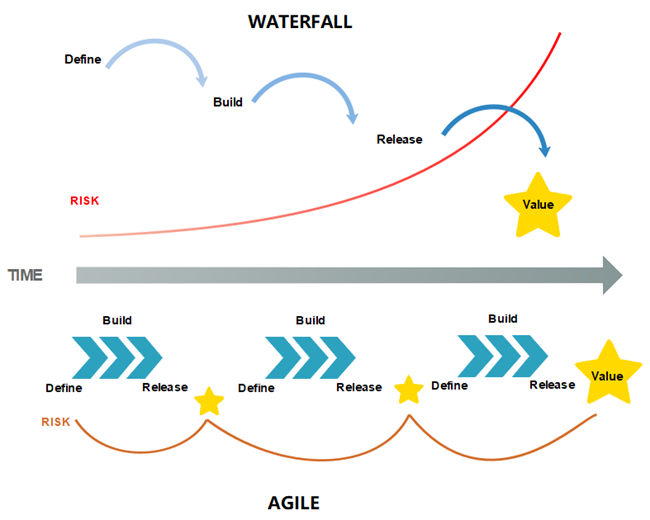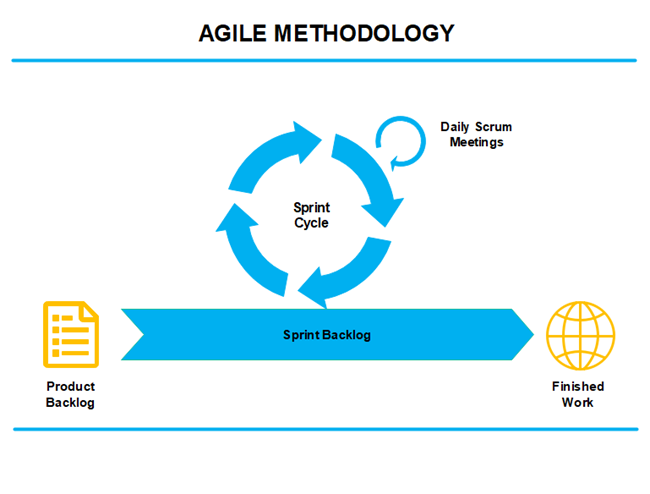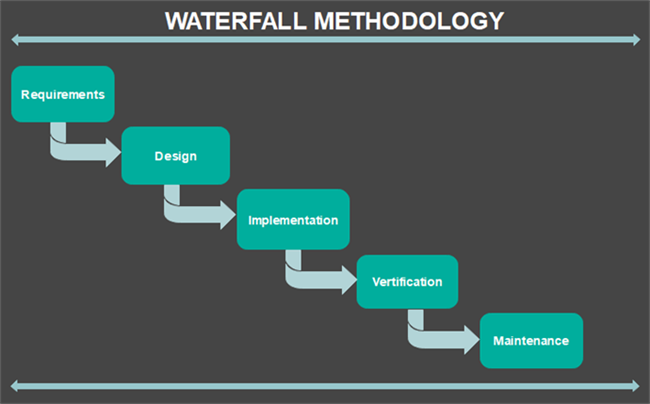Agile VS Waterfall: A Complete Comparison
Do You Want to Make Your Project Management Diagram?
EdrawMax specializes in diagramming and visualizing. Learn from this Agile VS Waterfall comparison to know everything about the Project Management Diagram. Just try it free now!
Which model should you use for project management? The answer depends on what stage your project is at—and on your available resources. There are two types of Software organizations: those that run on the Agile software development model and those that run on the Waterfall software development model. In this article, we want to look at both the Waterfall and agile models.
- Part 1: What is Agile and Waterfall
- Part 2: Similarities Between Agile and Waterfall
- Part 3: Differences Between Agile and Waterfall
- Part 4: The Comparison between Agile and Waterfall
- Part 5: Agile VS Waterfall: Which one should you use?
- Part 6: Free Waterfall and Agile Methodology Creating Software - Free to Use
- Part 7: Conclusion
1. What is Agile and Waterfall
Software development projects can be divided into two main types: The Waterfall Model and the Agile Model. A waterfall model project has a fixed schedule and budget and involves a sequence of defined steps to build a project. An agile model project has an evolving scope and is designed to be flexible and responsive to changing conditions. Both process models are based on the idea that each task should be broken down into smaller steps. However, they differ in the way they deliver. In waterfall projects, everything is done according to a planned schedule, with the product's budget, scope, and quality controlled by the project's beginning. In agile projects, decisions are made at the outset, and the team collaborates in the software solution's planning, delivery, and ongoing maintenance.
The Agile methodology is a project management tool in which the project team manages the project by dividing it into several stages. It involves constant collaboration with the stakeholders and non-stop improvement and iteration at every step. The Waterfall methodology is a kind of model that breaks down project activities into systematic linear sequences; hence, it’s also called the linear-sequential life cycle model. In this methodology, the subsequent phases rely on the deliverables of the previous one and correspond to the specialization of tasks.
What is Agile
Agile (also called Scrum) is an iterative approach to software development. Agile focuses on creating software with rapid feedback cycles and building collaboration between business and technology in early-and-often. The goal is to create better software by working with stakeholders throughout the process instead of following a linear plan. An agile team has high autonomy in planning, developing, testing, and deploying software. The team has a minimum set of process controls that define how work should be done and by whom.
What is Waterfall
In software development, waterfall software project management is a type of software project management where the design, development, and testing processes are carried out in separate phases. The purpose of such a process is to ensure the completion of a project, which usually involves large-scale software development, by breaking it into small, separate tasks. The waterfall model is also called sequential development or sequential model.
2. Similarities Between Agile and Waterfall
Before delving into what sets Agile and Waterfall apart from each other, there is a list of what they have in common below.
- They have similar goals, which are to produce high-quality software applications and make clients happy and content.
- They perform the same activities, which include collecting requirements, designing, developing, testing, and deploying.
- The foundation of a project involves planning, bringing the project to life, and monitoring the project’s progress in the two methodologies.
3. Differences Between Agile and Waterfall
Analysis of feasibility
Waterfall methodology: This process takes quite a lot of time to prevent reworking in the following phases of the project. It involves analyzing cost and benefit to determine if the plan is financially, technically, and operationally achievable. At times it may lead to a business case.
Agile project management: This takes as little time as possible. You can contact clients in good time in the first stages of the project and settle the project requirements and task details.
Planning process
Waterfall project management: Planning in detail is very crucial and is done just once. It allows them to achieve the set goals of the project without making any alterations to the requirements or scope of the project. You can track the formulated plan at the beginning of the project in the entire project progress after it’s set the baseline. You can make no change.
Agile methodology: Not done in advance but when the team is prepared to take on a particular set of the requirements and begin to outline the development. In this case, planning is an ongoing process since the team works on an active sprint. Changing the plan is allowed, but you cannot add new requirements to an active sprint.
Monitoring and tracking processes
Waterfall methodology: You can monitor the project’s progress. Frequent status reviews are carried out to analyze the development. Afterward, the status reports will be sent to the management team and the project sponsors. The project managers also make weekly/monthly reports of status and share them with the stakeholders.
Agile methodology: It is different as the progress gets measured in each sprint. The project team does this, then the sprint reports are handed over to the stakeholders. Another way of tracking project progress is through the demo of the built functionality.
Roles delegation
Waterfall methodology: Project team members get assigned particular tasks, and one can work on only their delegated role. It is not up for any change whatsoever in the project life cycle. For example, a developer-only takes care of development tasks and cannot handle any other work.
Agile project management: The teams are self-organizing and can switch roles among themselves. Or they can work in cycles, for example, a developer can assist a tester in the testing process. There is only a case of scrum master exception in which you can swap with the project manager.
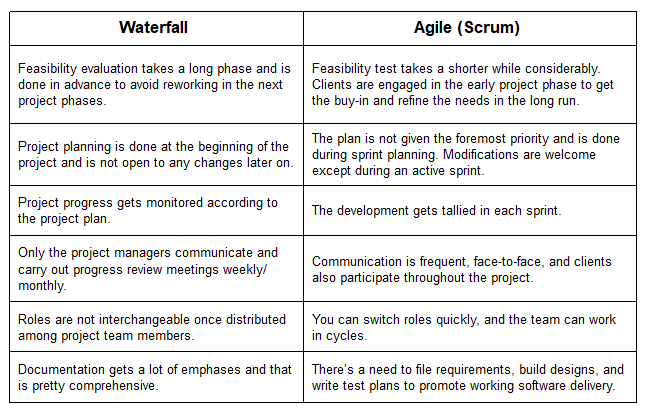
Use a comprehensive diagram design tool to create an Agile or Waterfall program diagram:
EdrawMax
Efficient Project Chart Maker >>
- Superior file compatibility: Import and export drawings to various file formats, such as Visio
- Cross-platform supported (Windows, Mac, Linux, Web)
4. The Comparison between Agile and Waterfall
Next, we’ll see what makes these methodologies unique and their pros and cons.
Agile
a) What makes it stand out?
Agile is a project management tool that majors on collaboration, adaptive planning, and continuous improvement. It has precise principles such as:
- Brief but detailed feedback loops.
- Enhanced and purposeful collaboration.
- Creation of shippable enhancements and upgrades of output.
- Openness.
b) Pros of Agile
- Fast development cycle, output delivery is never slackening.
- Reduction of project cost and risk.
- More control over the development process. Changes can be accommodated in the current version of the product whenever clients bring them up. Also, if needed, changes in the project requirements are possible in later phases of the project development.
- Use of open communication and collaboration with clients. After every sprint, the working features of the software are sent to clients hence making them content and confident in the production.
- Simplification of the system architecture. A lot of emphases are put on how to best design the software.
- Ability to innovate and change without much disruption
c) Cons of Agile
- It isn't easy to estimate accurately that how much time and money it will take to complete a project at the outset. Predicting the result can be tough when outlined requirements aren’t clear.
- The project requires a solid foundation and a comparable skill level from the beginning. It is ought to estimate the efforts required at the beginning of the software development life cycle.
- Very less documentation. Poorly written documentation can lead to poor communication between team members and make it difficult for new team members to access information pertinent to their responsibilities.
- Inadequate project boundaries may cause a project to expand, resulting in a situation where the work is never finished.
- It is vulnerable when faced with unknown risks that can affect the project progress.
d) Agile example
Scrum is a famous and widely-used example of Agile methodology.
Waterfall
a) What makes Waterfall stand out?
It has the following features:
- It has a linear sequence in which the next phase depends on the successful completion of the previous one.
- It is based on three principles: extensive documentation, minimum client participation, and sequential structure of project implementation.
b) Pros of Waterfall
- It has well detailed and reliable time and budget estimates.
- The development process is more secure with a b foundation.
- It has extensive documentation.
- It is a straightforward project management tool that’s precise and commendable for small projects with well-understood needs.
- It is easy to manage due to its tight and rigid model.
- Its project phases are well defined, and tasks can easily be arranged.
- Ensures that every file is synchronized in every repository to ensure the same version of each file.
c) Cons of Waterfall
- Poor model for long and ongoing projects. Unforeseen problems and hurdles need pretty much time, money, and human resources to deal with. It affects the overall output severely.
- Not suitable for projects where requirements can be changed in the future. It is considered to be a rigid and inflexible process. Since it’s done, changes in project requirements are not allowed and roles are not switchable.
- Not a good model for complex and object-oriented projects. It lacks regular meetings and communication. Hence, you need to feedback and test in the last phase of the project.
d) Waterfall example
A common Waterfall model example is the Software Engineering model.
5. Agile VS Waterfall: Which one should you use?
Before adopting Agile or Waterfall, it is wise to consider factors such as:
- Project requirements and regulations. Does the project consist of precise regulatory requirements without any future changes?
Yes: choose Waterfall. No: use Agile. - Stringent organizational processes. Does the firm have strict project processes that one must follow them?
Yes: use Waterfall. No: use Agile. - Client participation in project progresses. Do clients require an update of the project process frequently?
Yes: choose Agile. No: select Waterfall. - Nature of the project. Is it an already existing product that requires some upgrading?
Yes: use Waterfall. No: choose Agile. - Time scope of the project. Is the project deadline set and cannot be altered in any situation? Is the period short?
Yes: use Waterfall. No: use Agile. - Budget of the project. Is it already drawn up and inflexible?
Yes: use Waterfall. No: use Agile.
Now, is there a way that you can use these two development methodologies to work on a single project? Yes, and you can find out the answer in the Agile-Waterfall Hybrid example below.
To deliver a solution in a way that wisely utilizes time, team members, and other resources to meet the demands of the customers, Edraw Max, a multi-management platform, provides the hybrid Agile-Waterfall method example.
They achieve this by:
- Gathering and filing all project requirements up first and foremost.
- Designing the project model.
- Going into the development phase of a software or product.
- Testing the product when the development is complete.
- Receiving feedback on what has been created up to this particular project stage.
- Making changes according to the feedback until a perfect output is realized.
- Deploying the product and getting the final outcome.
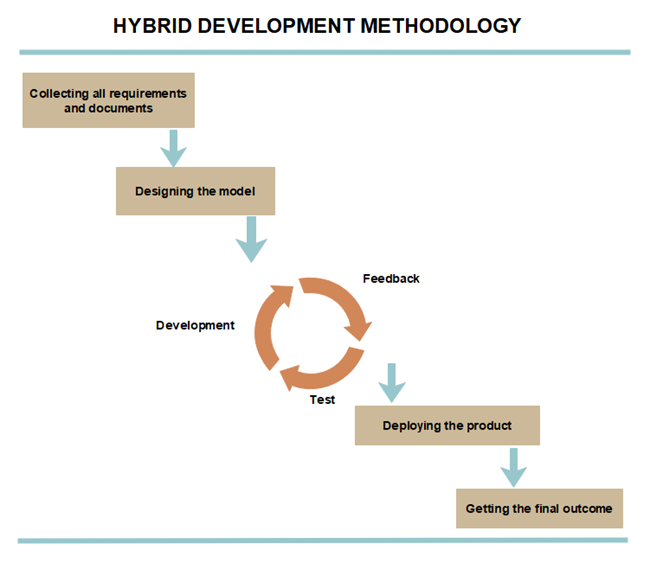
1. Download Agile-Waterfall Hybrid template by clicking here for free.
2. Use EdrawMax fishbone diagram maker to open and use thisAgile-Waterfall Hybrid template. Download from the button below.
6. Free Waterfall and Agile Methodology Software
EdrawMax is a free application designed to make creating flowcharts easier. The most common use of this application is for creating flowcharts and workflows. Flowcharts can be used to show the workflow of your organization. It will help in several ways, including visualizing your workflow, identifying bottlenecks, and improving overall efficiency.
- EdrawMax is perfect for beginners who wish to create their first diagram.
- It's so simple and easy to use, yet with enough power under the hood to make you think you're using an expert-level tool.
- EdrawMax is the ideal software solution for creating various diagrams because it gives you the freedom to choose from multiple diagram templates to make the job faster.
- EdrawMax has always stood out from the crowd because of its unique approach to workflow.
- It allows you to create professional diagrams and use it to create project schedules, detailed maps, and database designs.
7. Conclusion
The debate about Agile vs. Waterfall goes back to the late 1990s. This is an important topic from decades, with both sides presenting their arguments with passion. These models can be as simple as a table laying out all the work you need to do for a project. Or they can be complex models that combine many aspects of a project.
In this article, we have looked at Waterfall methodology and Agile methodology. The table displays the differences and similarities between these two methodologies at a glance. Also, the article gives you a guideline on getting the appropriate project software based on the nature of the project. Finally, you can use Waterfall methodology and Agile methodology to achieve an exceptional output of your project called the Agile-Waterfall Hybrid method.
EdrawMax makes it easy to create these models. EdrawMax includes an extensive library of components that can be dragged and dropped onto the model canvas. They can be reused and combined to form the exact model you need. Once you're finished, the model can be exported to many different formats and sent to stakeholders for review.
